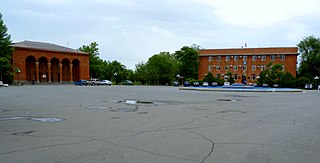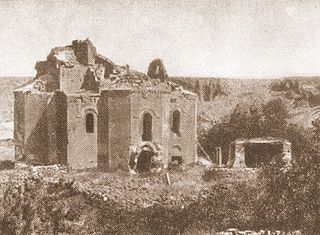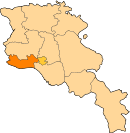Coordinates: 40°06′53″N43°40′15″E / 40.11472°N 43.67083°E

A geographic coordinate system is a coordinate system that enables every location on Earth to be specified by a set of numbers, letters or symbols. The coordinates are often chosen such that one of the numbers represents a vertical position and two or three of the numbers represent a horizontal position; alternatively, a geographic position may be expressed in a combined three-dimensional Cartesian vector. A common choice of coordinates is latitude, longitude and elevation. To specify a location on a plane requires a map projection.
Contents
| Yervandashat Երվանդաշատ | |
|---|---|
Overlooking village of Yervandashat. | |
| Coordinates: 40°06′53″N43°40′15″E / 40.11472°N 43.67083°E | |
| Country | Armenia |
| Marz (Province) | Armavir |
| Founded | 3rd century BCE |
| Population (2001) | |
| • Total | 695 |
| Time zone | (UTC+4) |
Yervandashat (Armenian : Երվանդաշատ) is a village in the Armavir Province of Armenia. The village has a ruined basilica dated to the 4th or 5th century and the Saint Shushanik church of the 10th to 17th century. Along the main highway leading to and from the area are khachkar monuments. It is named after the nearby Armenian historic city of Yervandashat
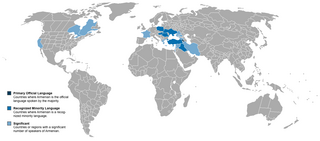
The Armenian language is an Indo-European language spoken primarily by Armenians. It is the official language of Armenia. Historically being spoken throughout the Armenian Highlands, today, Armenian is widely spoken throughout the Armenian diaspora. Armenian is written in its own writing system, the Armenian alphabet, introduced in 405 AD by Mesrop Mashtots.

A village is a clustered human settlement or community, larger than a hamlet but smaller than a town, with a population ranging from a few hundred to a few thousand. Though villages are often located in rural areas, the term urban village is also applied to certain urban neighborhoods. Villages are normally permanent, with fixed dwellings; however, transient villages can occur. Further, the dwellings of a village are fairly close to one another, not scattered broadly over the landscape, as a dispersed settlement.
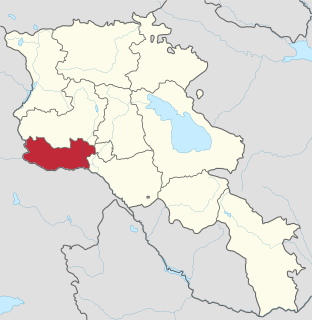
Armavir, is a province (marz) in the western part of Armenia. Located in the Ararat plain dominated by Mount Ararat from the south and Mount Aragats from the north, the province's capital is the town of Armavir while the largest city is Vagharshapat (Etchmiadzin). The province shares a 72 km (45 mi)-long border with Turkey to the south and west.
1 km east of the modern village -within the Turkish borders- are the ruins of ancient Yervandashat, a city founded by King Orontes IV (the last of the Orontid Dynasty), in 210 BC. The ancient town sits upon an escarpment overlooking the junction of the Arax River and Akhurian River. According to Movses Khorenatsi, Orontes founded Yervandashat to replace Armavir as his capital after Armavir had been left dry by a shift of the Arax River.
Orontes IV was the son of King Arsames and is recorded as ruling Armenia from inscriptions found at the historic capital of the Orontid dynasty, Armavir. He was the founder of the city of Yervandashat. In his reign the religious site of Bagaran was founded. Large bronze statues in the Hellenistic style of the gods, Zeus (Aramazd), Artemis (Anahit) and Herakles (Vahagn) were brought there and set up in temples dedicated to them. He is also said to have founded a shrine at Armavir dedicated to Apollo (Mithra), a golden statue of four horses pulling a chariot with Apollo as god of the Sun. This was later destroyed by the Sassanid Persian army in the 4th century AD.
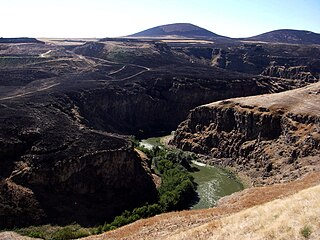
The Akhurian, Akhuriyan, Akhuryan or Akhouryan is a river in the South Caucasus. It originates in Armenia and flows from Lake Arpi, along the closed border with Turkey, forming part of the geographic border between the two states, until it flows into the Aras River as a left tributary near Bagaran. The Akhurian drains an area of about 9,500 square kilometres (3,700 sq mi) and has total length of 186 kilometres (116 mi).
Ancient Yervandashat was destroyed by the army of the Persian King Shapur II in the 360s.

Shapur II, also known as Shapur II the Great, was the tenth Shahanshah of the Sasanian Empire. The longest-reigning monarch in Iranian history, he reigned for his entire 70-year life from 309 to 379. He was the son of Hormizd II.
However, The archaeological site has not been subject of major research, but preliminarily, the fortifications and some remains of palaces have been uncovered.



